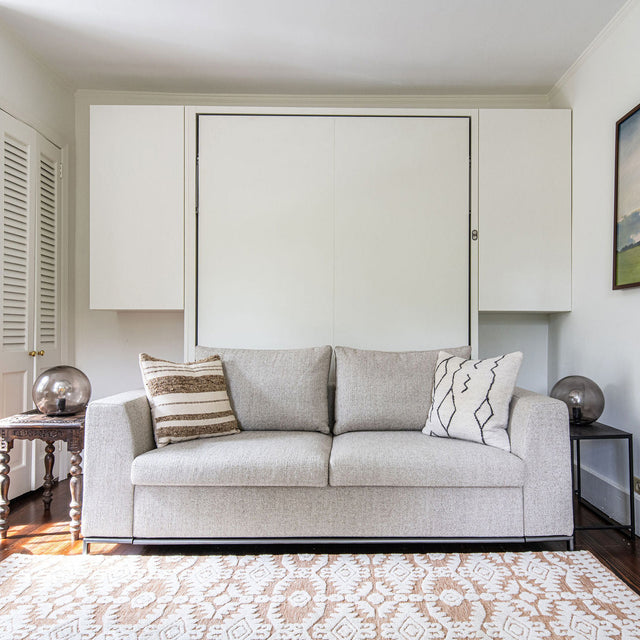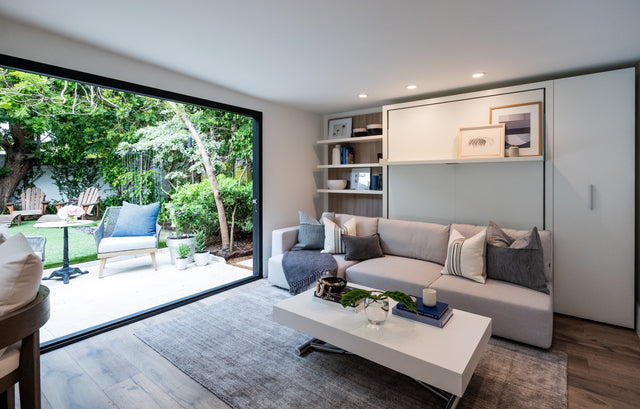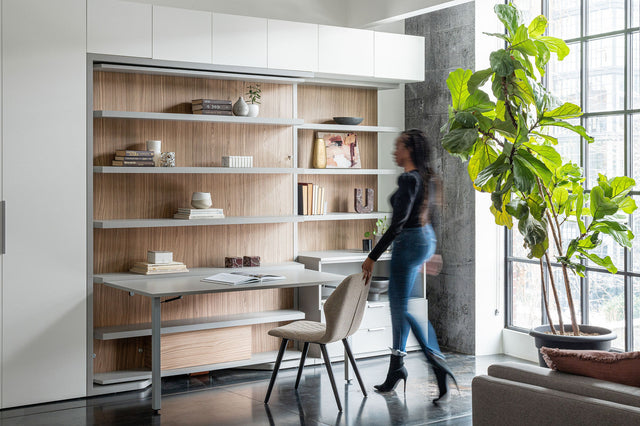Meet the Piotti Brothers of Art Nova

Meet the Piotti brothers Riccardo, Filippo, and Alessandro — respectively Head of Sales, Head of Product Design, and Head Prototypist of the innovative Italian furniture company Art Nova, maker of the revolutionary Flex modular sofa. Resource VP of Sales and Design Challie Stillman sat down with two of the three Piotti brothers to discuss their roles in the family business, their design philosophy, collaborations with famous brands, and more.
Despite being in business for over 40 years, Varese-based furniture maker, Art Nova, is described as having the dynamism and freshness of a start-up. The company’s founder, Mario Piotti, spent his early career as a prototypist and technical director for some of Italy’s biggest and best-known upholstered furniture producers of the day. Along with a well-defined aesthetic vision, his considerable design and model-making skills led him to establish his own shop in 1976, the year his eldest son, Filippo, was born.
Mario died in 1983; today, Filippo and his two brothers, Riccardo and Alessandro, run Art Nova, extending their father’s vision to the international furniture market. Partnering with Italian furniture brands Mobilform, Salcom, and Turati (together, a consortium called SmartHome) the four successful Italian furniture brands presented together at the 2015 Salone del Mobile where Art Nova first introduced their Flex Sofa.
In the years following the 2015 Salone, Art Nova continued to refine the design of the Flex, introducing and outdoor version and producing the Flex Air, which won the 2018 Red Dot Design Award.
Read the full interview with Riccardo and Filippo Piotti below.
Riccardo on joining the family business.
Challie: >We’ve been so thankful to have found you; you’ve really added an incredible element to our collection. We’re very happy to represent you in North America.
Riccardo: We are proud to work with you and others in countries around the world. We’re always trying to improve things with brand-new collections, super high-quality fabrics, research. We’re always looking for new ideas.
Challie: Talk a little bit about how you ended up working in the family business. Was it always expected? Did you have a choice in the matter? How did you end up in the roles that you did?
Riccardo: I was free to choose my own way. There was no pressure from my family to be a part of the family business, but when I was a child I was always playing with the fabrics, with the bedding, with the foam. So growing up the family business was part of the daily conversation and was a common interest for everyone. Then when doing my studies in business administration, Art Nova always provided me with a model to put my studies to practice.
Filippo designs. Alessandro, my other brother, has a natural talent for realizing ideas, so Filippo can design something and Alessandro can produce it. I’m in Sales. We share ideas and we’re always interested in each other’s work. It was a natural choice for me to be a part the family business.
Filippo on design and external influences.
Challie: Filippo, how would you describe your design philosophy and what you bring to the collection?
Filippo: My creative process is a mix of functionalism and aesthetic principals — two parts that work together, that collide: one functional and one poetic. We are influenced not only by our internal thoughts but by everything around us; especially today because everything changes in a moment and day by day. I don’t think I have a single design philosophy; it changes every day due to external influences, cultural influences. For me, that’s everything that’s around me, everything that’s around us: what we see, what we touch, our travels, how people dress — even your house that I see in the video! All of these, for me, are external influences.
In particular, I observe a lot. I observe people: how they move, how they use objects, how they sit down; for example, you at this moment with your arms in a particular way. When you observe you learn something about how people use objects — like how a fashion designer observes streetwear. I usually look at how people use public and domestic spaces and how they interact with objects and spaces.
Observation is a part of my mind; another part, the aesthetic, is also influenced by art, fashion, cities. I really like fashion. I think fashion and design have a very close connection together.
As in fashion, a design object works when it evokes emotion and at the same time is comfortable.
A more user-centric approach.
Challie: We are just coming out of 6 weeks, almost two months, of being indoors all the time, and you two have been working remotely. How has this influenced you as a designer? Has it sparked any new ideas about how we are going to be using our homes differently going forward?
Filippo: In these two months of working at home, I have more awareness of what I like and what is needed in interior design. Someone once said less is more — and for me now, I would say less, but better. In this interpretation, our new interiors must be re-thought according to this concept of less but better. This will mean not more sophisticated projects — they will appear simpler and more useful. The user is always at the center, not the designer. I think about customization and not industrialization.
Challie: We’ve always appreciated your ability and willingness to listen. As you pointed out, it’s about the client. This is about what’s going to enhance people’s lives.
Riccardo: Always, we speak with the client — always from the beginning. When we start with a product we show it to our manager of finance and we try to sell it to him. Trying to sell it to the client is the inspiration to upgrade the product.
For example, in 2015, we presented the Flex sofa at the [Milan] fair. The fair goes for five days, and on the first day, in the morning, the customer sat on the sofa and said, “I need a higher support for my back.” In the afternoon my brother Alessandro came with a better cushion for the customer… We really heard what the client needed, and we want to make them happier and more comfortable — because we know that it’s important not only to sell the sofa, but to create a product that’s special and that fits the need of the customer.
The inspiration for, and future of, the Flex Sofa.
Challie:Filippo, is there a product in the collection that you are particularly proud of? What is your favorite?
Filippo: There are many Art Nova products that I love, obviously, because they are born from an idea and goes on to excellent production. If I have to think of something that I’m really proud of, it’s not a single product like Flex or like an armchair or a table — it’s a mix of products, a collection, a creative thought behind a group of products that work together. Flex and Dynamic, for example, are products that live together. I’m very proud when I create products that can mix and live and work together, creating a new way of living in the space.
Challie: When was the moment you realized that someone needed something like the Flex with moveable backrests? Where did that spark come from?
Filippo: There is a moment when you use an object — not a moment when you find an idea, but a moment that you find something that is wrong. If you find something that is wrong, you think about a new idea. I understood that the functional two faces of the sofa and the side tables were never exactly in the position you needed. For example, the backrests are never in the right position, it’s too far, or the seat is too short, and the table is not perfect the height. And so you find inspiration when you find a wrong thing — the idea here is moving the two faces and moving two parts together.
Challie: What is the thing that’s not working that’s going to create a new idea?
Filippo: There are a couple of things: this year we moved backrest, we moved the table, we have a large seat. But there is a thing that I am working on for many years — to move the height of the seat. The only thing in this moment that you cannot adjust is the height of the seat. You can work [comfortably] with the current height of the sofa, but only for two or three hours.

Art Nova on the international stage.
Challie: Riccardo, is there some project that you’ve worked on — some installation, some collaboration — that you’ve really loved?
Riccardo:A significant project for me was my first Salone del Mobile. Salone del Mobile 2015 was my first time entering the international market, and this is the biggest international event for furniture. We were strong from our success in our Italian market, and we wanted to share this idea on a bigger stage. There was the new sofa with the mobile backrests that rethinks the concept of the traditional sofa. It was on this occasion we met Resource Furniture, who understood the idea and the potential of the sofa.
There are also other two projects that I want to mention. We have a collaboration with a shop to use our sofa for the lounge of the international Ferrari tour, and we have another collaboration with Nike for their headquarter offices in Europe. I customized the sofa with the brand colors of Nike, and some other customizing. It was really exciting.
Challie: It brings you onto the international stage to have collaborations with such well-known brands. It really tells people the quality of Art Nova — that these brands trust you and believed in you really says a lot, and it’s very exciting.

On collaboration.
Challie: Going back to the first Salone, how was it that it came together between you, Turati, Mobileform — the whole family of brands — how did you enter into that agreement to have all of those brands represented in one booth?
Riccardo: The first Salone with the other brands… we are really lucky to work with smart people. We were in the same market, and they found us. It’s important because, for us, the sofa is not only a thing that works alone. It’s a thing that works with all the other furniture in the house. And everyone, each company understands that and everyone took steps to stay closer to the others, so we are not a company that works alone. We are companies that work together. We suggest to each other what we can do, how we can collaborate — also supplying new materials, new ideas — we share everything. We are really, really, lucky to find not only a collaboration, but also a friend.
Challie: It’s something that I think a lot of other brands can learn from. By sharing ideas and collaborating, you were actually able to enhance each other and make the entire home stand out from the rest of the fair.
Filippo: When you want to propose a sofa, you can’t propose only the single object. It’s impossible to have Salone del Mobile stand with only three, four, five sofas with nothing else. We have to suggest a new way to live in interior spaces, so the sofa has to have relation with the walls, with the table, with the kitchen. I’m not creating a sofa, I’m creating a new way to live in the space. You must think about the spaces, not the single object, it’s important to delegate and mix with other industries that work with other objects that live with the furniture.











